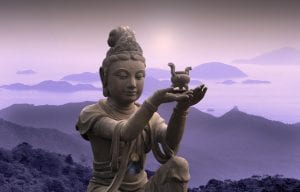Buddhist Funeral Service Rituals

Note: Buddhist funeral customs vary between traditions or “schools” and even within schools, depending on the country—for example, Zen in Taiwan and Zen in Japan are different. The following information is generalized to fit many or most Buddhist traditions. If you have specific questions relating to Buddhist funeral customs for an individual sect, we recommend that you consult with your spiritual advisor.
Funeral customs differ within the various Buddhist sects and from one country to the next. Some funerals are very ritualistic and traditional, while others are quite simple, solemn, and dignified. Rather than spend lavishly on expensive but perhaps meaningless traditions and rituals, the family and friends may donate to a worthy cause and transfer the merit to the deceased.
Peace and serenity are hallmarks of a Buddhist funeral. An altar is set up to display the deceased’s portrait, along with offerings of candles, incense, flowers, and fruit. An image of the Buddha is placed beside or in front of the altar.
According to Buddhist funeral customs, a service may be presided over by monks, who will deliver a sermon and perform Buddhist rites. If a monk is unavailable, others may conduct the service. Rituals that transfer merit to the deceased may be performed by family or other mourners, such as offering cloth to the presiding monk on the deceased’s behalf, pouring water from a vessel into an overflowing cup, preaching, and giving offerings or almsgiving.
At a traditional Buddhist funeral, the family will wear white or cover their clothing with a traditional white cloth, along with a headband or armband. Mourners may also:
- Walk with sticks to symbolize that grief has left them the need for support
- Chant or sing appropriate sutras (prayers)
- Bring offerings of flowers and fruit
- Burn incense to sweeten the air
- Ring gongs or bells
Although Buddhists understand that death is not an end, only a transition from one form to another, it is acceptable to show grief. In doing so, friends and family members acknowledge the loss of their loved one. The focus, however, should be on understanding the transiency of life, thinking about one’s own mortality as an impetus to make life meaningful, and performing good deeds on behalf of the deceased person.
The deceased may be cremated or buried, although cremation is traditional. Monks, if present, will perform last rites before the casket is sealed. Family members may assist in lifting the casket as a final act of service, while others attending may observe a moment of respectful silence. During the funeral procession, family members may walk behind the hearse; all attendees should be sending good thoughts to the family and contemplating the impermanence of life.
The Buddha said,
Life is a journey.
Death is a return to earth.
The universe is like an inn.
The passing years are like dust.
Regard this phantom world
As a star at dawn, a bubble in a stream,
A flash of lightning in a summer cloud,
A flickering lamp – a phantom – and a dream. *
*Vairacchedika 32.
| Buddhist Funeral Customs Quick Reference Guide | |
|---|---|
| Length of Service | 45 – 75 minutes |
| Flowers? | Yes – white or yellow. (See our Sympathy Flowers) |
| Food? | No |
| Dress Code? (Men/Women) | Dark & Casual |
| Recording Devices? | No |
| Source of Readings? | Sutras |
| Open Casket? | Always |
| Return to Work? (Days) | No specific time |
| No. of Days to Mourn? | 90 |
| Embalming? | Accepted |
| Cremation? | Preferred |
| Body/Organ Donation? | Valued as an act of compassion but up the individual’s preference. |
Resources:
www.buddhanet.net/pdf_file/buddhist_funeral.pdf
www.pbs.org/edens/thailand/buddhism.htm
www.buddhanet.net/e-learning/5minbud.htm
/www.youtube.com/watch?v=9_FPZeXKpNU
www.youtube.com/watch?v=iWIj_hdLwgc